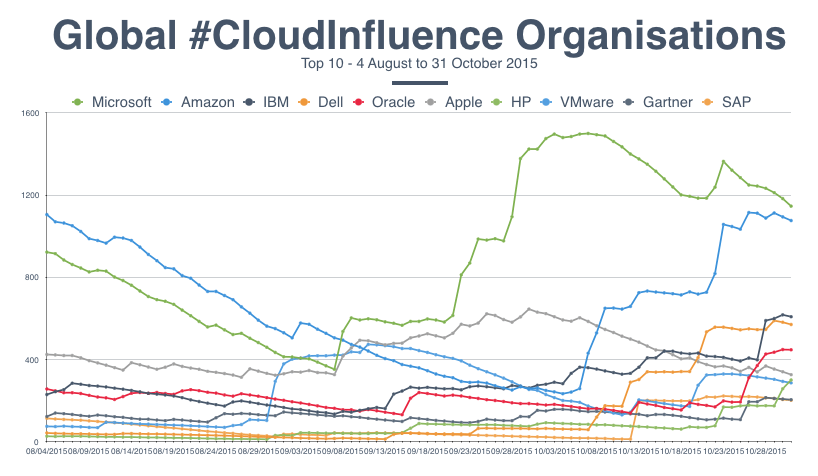Retaining top slot in the global #CloudInfluence rankings was Microsoft. The company has been shifting its focus to software and cloud services as demand for the Windows operating system slows in a weak PC market – despite the launch of Windows 10. The strategy lead by Satya Nadella was applauded by Bernstein analyst Mark Moerdler (both appear in the individual rankings this month). It involves a reduced reporting structure with three rather than six segments, including its growing cloud and mobile businesses. Recently the firm announced that Azure revenues have more than doubled.
October was a busy month with re:Invent (the AWS fan fest) followed immediately by both Oracle World (the Ellison fan fest) and the Tokyo OpenStack Summit (the fan fest for the open cloud OS).
[easy-tweet tweet=”Re:Invent gave AWS a major boost, helping it to return to second place in the rankings.” via=”no” hashtags=”cloudinfluence”]
Re:Invent gave AWS a major boost, helping it to return to second place in the rankings. Among the many new services announced was the AWS Database Migration Service and AWS Scheme Conversion Tool designed to simplify the challenge of switching databases, as AWS directly targeted database service renewals and therefore Oracle’s core market. Oracle World saw Larry Ellison and his horde fight back, throwing everything (including the kitchen sink) at cloud with a host of new services. Interestingly Oracle, unlike HP, chose to maintain a presence in public cloud – promising to compete directly with AWS on price rather than scale – although exactly how Oracle can continue to compete on price in the longer term without scale remains unclear. Oracle was in 5th in the rankings behind both IBM and Dell.
IBM maintained its challenge to the mega-scale cloud players with yet more strategic acquisitions as it continues to build out its cloud proposition. And Dell opted to steal the headlines with the biggest tech acquisition in history – namely the $67m purchase of EMC and with it 80% of VMware (as we covered in our earlier blog).
HP made it into the top ten in the rankings for the first time, and indeed the last time as a single entity. Its retreat from public cloud and its 1st November split into two separate firms raising its profile higher than its cloud activities ever managed to do. VMware also appeared in the top ten with speculation on its future following Dell’s acquisition of EMC.
While the Tokyo OpenStack Summit (which we attended) gave all the main OpenStack players a slight boost, questions remain about the long term viability of the open cloud OS. The concerns were probably best outlined by Peter Willis, BT’s chief researcher for data networks, when he broke ranks among what has otherwise been a united front from all OpenStack vendors and supports, with an outspoken presentation at the SDN & Openflow World Congress in Germany. He outlined six challenges that OpenStack needs to address to be taken seriously: including the connection of virtual network functions (VNFs), service chain modification, scalability, so-called “start-up storms,” the security of OpenStack over the Internet and backwards compatibility (see http://ubm.io/1HsIjga ). In Tokyo Jonathan Bryce, Executive Director of the OpenStack Foundation, acknowledged that BT’s concerns were valid and that they needed to be addressed, but without outlining how or when its contributors would be doing so. With Azure and AWS practically doubling their cloud revenues each year, Bryce declined to suggest a rate of growth that would be acceptable for the OpenStack community if it is to keep pace with the mega scale vendors as it attempts to become enterprise ready and address BT’s concerns.
Notable appearances further down the rankings included The Weather Company in 17th – one of IBM’s recent acquisitions. Normally we exclude weather companies from our rankings as they talk about the wrong kind of clouds, but in this case their inclusion was valid. Indeed if the combination of the Weather Company’s meteorological data and IBM Watson’s predictive analytics can provide improvements in weather forecasting then I for one am all for it.
[table id=56 /]
NOTE: the Compare the Cloud #CloudInfluence league tables, are based on a broad big data analysis of all major global news, blogs, forums, and social media interaction over the past 90 days. The league tables provide a snapshot taken at a particular point of time of the respective influence of both organisations and individuals over the last quarter. Companies that were particularly active in the given period will feature more prominently.
Bill is a tech industry veteran and experienced corporate marketing and communications professional with over 20 years spent working in blue chip organisations mostly in pan-European and global communications roles. He is also a regular commentator on #Cloud, #SocialSelling and #InfluencerMarketing, as well as a dad with a passion for technology, economics, politics & Arsenal FC.




